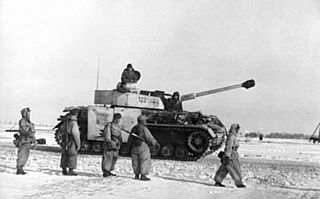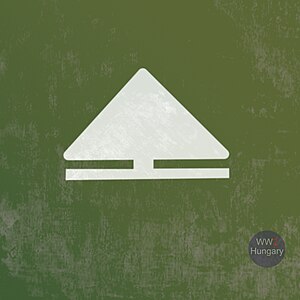A mechanised corps was a Soviet armoured formation used prior to the beginning of World War II and reintroduced during the war, in 1942.
The 16th Army was a Soviet field army active from 1940 to 1945.
The 2nd Mechanised Corps was a formation in the Soviet Red Army during the Second World War.
The 4th Airborne Corps was an airborne corps of the Red Army in World War II. It fought in the Vyazma airborne operation, an unsuccessful landing during the Rzhev-Vyazma Offensive.
The 5th Mechanised Corps was a mechanised corps of the Red Army, formed on three occasions. It was first formed in 1934 and was converted into the 15th Tank Corps in 1938. It was reformed in the Far East in 1940 and moved west before the German invasion of the Soviet Union. It fought in the First Battle of Smolensk, losing large numbers of tanks in the Lepel counterattack. The corps was encircled in the Smolensk pocket and after breaking out was disbanded in late August 1941. Its third formation, from elements of the 22nd Tank Corps, occurred in September 1942. The corps fought in: Operation Little Saturn, Operation Gallop, the Second Battle of Smolensk, the Dnieper–Carpathian Offensive, and the Second Jassy–Kishinev Offensive. In September 1944, it became the 9th Guards Mechanised Corps.
The 17th Tank Division was a tank division of the Red Army that was formed in mid-1940. The division suffered heavy losses during fighting against German forces during the Battle of Smolensk and was converted into a tank brigade in late August 1941.

The 252nd Rifle Division was the eighth of a group of 10 regular rifle divisions formed from cadres of NKVD border and internal troops as standard Red Army rifle divisions, very shortly after the German invasion, in the Moscow Military District.
The 32nd Guards Tank Division was a tank formation of the Soviet Army/Soviet Ground Forces. Its predecessor, the 9th Guards Airborne Division, was a Red Army Airborne division of World War II. On 19 June 1945, it became the 116th Guards Rifle Division. In 1946, it became the 14th Guards Mechanized Division. In 1957, it became the 14th Guards Motorized Rifle Division. In 1982, it became the 32nd Guards Tank Division, which was disbanded in June 1989.
The 61st Rifle Corps was a Red Army infantry corps during World War II, formed twice. The 61st Rifle Corps was formed firmed in Tula during September 1939. After Operation Barbarossa, it was transferred to the front in Belarus and fought in the Battle of Smolensk. After suffering heavy losses at Smolensk, it was disbanded in early August 1941. Reformed in spring 1943, the corps fought in Operation Kutuzov, the Lublin–Brest Offensive and the Berlin Offensive. The corps was disbanded after the end of the war in summer 1945.
The 20th Mechanized Corps was a mechanized corps of the Red Army. Formed in March 1941, the corps was almost entirely destroyed in the Battle of Białystok–Minsk and the Battle of Smolensk, in which it defended Mogilev.
The 17th Mechanized Corps was a mechanised unit of the Red Army. Formed in March 1941, the corps was destroyed in the Battle of Białystok–Minsk and reduced in size to the 147th Tank Brigade.
The 25th Mechanized Corps was a Mechanized corps of the Red Army. Formed in March 1941, the corps fought in the Battle of Smolensk. Its headquarters and that of the 20th Rifle Corps were combined in August 1941 to form the Bryansk Front headquarters.
The 23rd Mechanized Corps was a Mechanized corps of the Red Army. Its divisions fought in the Battle of Smolensk (1941) but the corps itself never fought as a unit. The corps became the second formation of the 23rd Rifle Corps.
The 14th Mechanized Corps was a mechanized corps of the Red Army. Formed in March 1941 and stationed in western Belarus, the corps was destroyed in the Battle of Białystok–Minsk in June of the same year.
The 11th Mechanized Corps was a mechanized corps of the Red Army, formed twice. The corps was first formed as one of the original two Red Army mechanized corps from the 11th Rifle Division in Leningrad. In 1934 it was transferred to the Transbaikal Military District and in 1938 became the 20th Tank Corps. The corps was reformed in March 1941 in western Belarus. After the German invasion of the Soviet Union, the understrength corps was destroyed in the Battle of Białystok–Minsk.
The 16th Guards Tank Division was a tank division of the Soviet Army and later the Russian Ground Forces.

The Kirovograd offensive operation, known on the German side as The defensive battle in the Kirovograd area, was an offensive by the Red Army's 2nd Ukrainian Front against the German 8th Army of Army Group South in the area of Kirovograd in central Ukraine between 5 and 16 January 1944. It took place on the Eastern Front of World War II and was part of the wider Dnieper–Carpathian offensive, a Soviet attack against Army Group South that aimed to retake the rest of Ukraine west of the Dnieper river, which had been occupied by Germany in 1941.
The 4th Guards Motor Rifle Division was a motorized infantry division of the Soviet Army during the Cold War.
The 33rd Guards Rifle Division was formed as an elite infantry division of the Red Army in May 1942, based on the 2nd formation of the 3rd Airborne Corps, and served in that role until after the end of the Great Patriotic War. It was the second of a series of ten Guards rifle divisions formed from airborne corps during the spring and summer of 1942. It was briefly assigned to the 47th Army in the North Caucasus Front but was soon moved to the Volga Military District and saw its first action as part of 62nd Army in the fighting on the approaches to Stalingrad. It was withdrawn east of the Volga in September, but returned to the front with the 2nd Guards Army in December, and it remained in this Army until early 1945. After helping to defeat Army Group Don's attempt to relieve the trapped 6th Army at Stalingrad the 33rd Guards joined in the pursuit across the southern Caucasus steppe until reaching the Mius River in early 1943. Through the rest of that year it fought through the southern sector of eastern Ukraine as part of Southern Front and in the spring of 1944 assisted in the liberation of the Crimea, earning a battle honor in the process. The Crimea was a strategic dead-end, so 2nd Guards Army was moved north to take part in the summer offensive through the Baltic states and to the border with Germany as part of 1st Baltic Front. During the offensive into East Prussia the division and its 13th Guards Rifle Corps was reassigned to 39th and the 43rd Armies before returning to 2nd Guards Army in April. For its part in the capture of the city-fortress of Königsberg the 33rd Guards would receive the Order of Suvorov. In mid-1946 it was converted to the 8th Separate Guards Rifle Brigade.
The 214th Rifle Division was an infantry division of the Red Army, originally formed in the months just before the start of the German invasion, based on the shtat of September 13, 1939. It was moved to the fighting front to join 22nd Army in late June and took part in the fighting between Vitebsk and Nevel in early July, escaping from encirclement in the process, and then played a significant role in the liberation of Velikiye Luki, the first Soviet city to be retaken from the invading armies. In October it was again encircled near Vyasma during Operation Typhoon and was soon destroyed.






